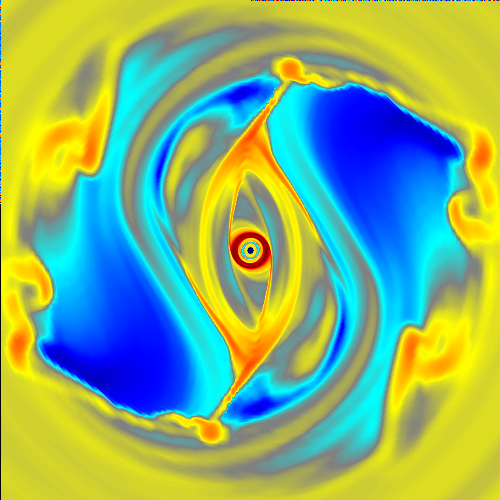
The non-axisymmetric gravitational potential in barred galaxies produces many interesting kinematic effects on stellar orbits, and even more interesting dynamical effects on the flow of gas. In particular, since gas is dissipative, it will shock at orbit crossings, and the resulting large non-radial hydrodynamical (pressure) forces can exert torques on the gas which alter its orbital motion. All of these effects can be investigated through hydrodynamical simulations.
This work has been done in collaboration with Glenn Piner (JPL), and Peter Teuben (UMd).
The general structure of the steady-state gas flow in a strongly barred galaxy has been understood for many years. The image below demonstrates this structure: it shows the density at late time in a simulation of the inner region of a barred galaxy using the CMHOG code. The orientation of the bar is vertical, and it extends for 5Kpc from the center of the galaxy (the image covers a region 16Kpc across). The gas follows a "cat's eye" morphology. The outer elliptical flow is really two shocks (thought to correspond to the dust lanes in observed galaxies) orientated roughly parallel to the long-axis of the bar. Where the bar ends, these shocks disappear into time-dependent filaments and blobs in the background gas. The pattern evident in the image is fixed relative to the bar.

The development and dynamics of this flow pattern is probably best understood through movies of the density in either MPEG format (1.3Mb) or animate gif format (21Mb). The movies are made in the frame of the bar (which remains vertical throughout).
A new aspect of these calculations is the use of a cylindrical non-uniform mesh with very fine resolution (2pc) near the galactic center. At this resolution, the most prominent dynamical structure is a circumnuclear ring formed at the inner ILR of the bar. Here the gravitational potential of the bar is nearly axisymmetric, and the flow reverts to circular orbits. Such rings are observed in most barred galaxies.
The simulations allow detailed examination of the kinematics of the gas in the bar. The flow is surprisingly complicated: gas flows down the dust lanes and "sprays" back out to large radii, only to encounter another shock at the opposite dust lane and repeat the pattern
More details can be found in the following papers:
``Nuclear Rings and Mass Inflow in Hydrodynamic Simulations of Barred Galaxies", by G. Piner & J.M. Stone, The Astrophysical Journal, 449, 508 (1995).